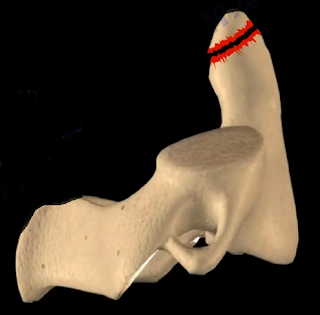Lisfranc Injury
Lisfranc injury is an important topic. If Lisfranc injury is
not diagnosed and treated properly, it can lead to an altered gait, midfoot
arthritis, and long term disability. Lisfranc injury indicated disruption
between the base of the 2nd metatarsal and the medial cuneiform. Lisfranc
injuries are a spectrum of injuries of the tarsometatarsal joints. Diagnosing Lisfranc
injury is important. Diagnosis is missed in about 20%-30% of cases especially
in multiple trauma patients. A high index suspicion is needed to prevent
progression of the foot deformity, chronic pain, and dysfunction. You may need
weight-bearing films for diagnosis of Lisfranc injury. Lisfranc injury may also
be associated with compartment syndrome. Lisfranc injury could be purely
ligamentous or can be associated with fractures. ORIF is better in cases of
fractures. Arthrodesis is better in cases of purely ligamentous injury. In general,
ligamentous injury does worse than fractures. The Lisfranc ligament is a large
oblique ligament that extends from the plantar aspect of the medial cuneiform
to the base of the second metatarsal. The Lisfranc ligament stabilizes the 2nd
metatarsal and maintains the midfoot arch. Osseous stability is provided by the
roman arch of the metatarsals and the recessed keystone of the 2nd
metatarsal base. Tarsometatarsal joint complex is divided into three units:
medial, middle, and lateral. The medial is the 1st metatarsal joint
at 6o mobility. The middle is the 2nd and 3rd
tarsometatarsal joints, and it is rigid. The lateral is the 4th and
5th tarsometatarsal joints; it is mobile which is why you do not
fuse the 4th and 5th tarsometatarsal joints. The dorsalis
pedis artery and the deep peroneal nerve both run between the first and second
metatarsal bases. A direct injury with a plantar displacement is more common. Indirect
injuries are more common than direct injuries. They result from axial loading
or twisting on a plantar flexed midfoot. Dorsal displacement of the 2nd
metatarsal is more common. Check the alignment of the dorsum of the 2nd
metatarsal with the middle cuneiform. Associated fractures are typically tarsal
fractures, especially a cuboid fracture. A “Nutcracker” fracture results from
twisting injury causing forceful abduction of the forefoot. It is a fracture of
the base of the 2nd metatarsal and compression fracture of the
cuboid. nd
metatarsal, at the navicular, and cuboid. Check for widening between the first
and second ray (more than 2 mm is an indication for surgery). In the lateral
view, check the dorsal displacement or subluxation of a metatarsal. It should
be at the level of the corresponding cuneiform. Check for the FLECK sign (bony
fragment). Avulsion fragment of the Lisfranc ligament from the base of the 2nd
metatarsal. The medial side of the fourth metatarsal should line up with the
medial side of the cuboid on the oblique view (30o). CT scan can be
useful and MRI can confirm purely ligamentous injury. These injuries should be
treated with a cast. For a dorsal sprain and no instability, the patient can be
treated with non-weight bearing cast for 6 weeks and return to activity
gradually. Surgery can be done for instability. Open reduction internal
fixation with cortical screws if there is bony fractures. When you do ORIF- you
need anatomic reduction. Hardware removal between 5-6 months (some surgeons
leave the hardware in place indefinitely). Arthrodesis if the injury is purely
ligamentous. Healing of the ligaments is less reliable than bony healing. Purely
ligamentous injury needs primary arthrodesis. Arthrodesis is also done in old injuries
if there is delay in treatment for if there is failure of open reduction and
internal fixation of Lisfranc injury. Midfoot arthrodesis is also used for
chronic Lisfranc injury that leads to severe midfoot arthritis with progressive
arch collapse and midfoot abduction. Fusion of the medial and middle column;
first, second, and third tarsometatarsal joints. Do not fuse the lateral column
(lateral column is mobile). For the lateral column, do reduction and
stabilization by k-wire fixation. Post-traumatic arthritis occurs in up to 50%
of patients. Patient may have altered gait and long term disability. Purely ligamentous
injury has a worse prognosis than injuries with fractures. Malalignment of the
fractures usually lead to arthritis.
Lisfranc classifications are not useful in deciding the treatment or the
prognosis of the injury. Severe injuries are obvious, easily diagnosed, and may
develop compartment syndrome of the foot. Injuries with minimal displacement
could be missed, and they will need surgery regardless of the classification. Arthritis
may develop even with minimal displacement. In general, there are three
patterns of injury: total incongruity, partial incongruity, and divergent. Total
incongruity occurs when all five metatarsals are displaced in the same
direction. Total incongruity occurs lateral or medial, with lateral being more
common. Partial incongruity occurs when one or two metatarsals are displaced
from the others. Divergent occurs when the lateral displacement of the lesser
metatarsals with medial displacement of the first metatarsal. The one thing all
these injuries have in common is disruption of the tarsometatarsal joint
complex. The patient has severe pain in the midfoot and is unable to bear
weight. There may be some swelling in the midfoot dorsally. Plantar bruising
may be present, especially medially. Tenderness over the tarsometatarsal joint.
Check the skin condition and rule out compartment syndrome. Check the neurovascular
status of the foot. Plantar ecchymosis is a classic clinical sign of potential
Lisfranc injury. Wight bearing standing x-rays with comparison views if x-rays
are normal and if the physician clinically suspects a Lisfranc injury. Another alternative
is to get physician assisted midfoot stress radiograph. Obtain three views: AP,
oblique, and lateral. Medial border of the second metatarsal should line up
with the medial border of the middle cuneiform on both the AP and the oblique
view. Check for fractures, especially at the base of the 2










